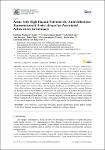Areas with High Hazard Potential for Autochthonous Transmission of Aedes albopictus-Associated Arboviruses in Germany
Thomas, Stephanie Margarete
Tjaden, Nils Benjamin
Frank, Christina
Jaeschke, Anja
Zipfel, Lukas
Wagner-Wiening, Christiane
Faber, Mirko
Beierkuhnlein, Carl
Stark, Klaus
The intensity and extent of transmission of arboviruses such as dengue, chikungunya, and Zika virus have increased markedly over the last decades. Autochthonous transmission of dengue and chikungunya by Aedes albopictus has been recorded in Southern Europe where the invasive mosquito was already established and viraemic travelers had imported the virus. Ae. albopictus populations are spreading northward into Germany. Here, we model the current and future climatically suitable regions for Ae. albopictus establishment in Germany, using climate data of spatially high resolution. To highlight areas where vectors and viraemic travellers are most likely to come into contact, reported dengue and chikungunya incidences are integrated at the county level. German cities with the highest likelihood of autochthonous transmission of Aedes albopictus-borne arboviruses are currently located in the western parts of the country: Freiburg im Breisgau, Speyer, and Karlsruhe, affecting about 0.5 million people. In addition, 8.8 million people live in regions considered to show elevated hazard potential assuming further spread of the mosquito: Baden-Württemberg (Upper Rhine, Lake Constance regions), southern parts of Hesse, and North Rhine-Westphalia (Lower Rhine). Overall, a more targeted and thus cost-efficient implementation of vector control measures and health surveillance will be supported by the detailed maps provided here.
Dateien zu dieser Publikation

